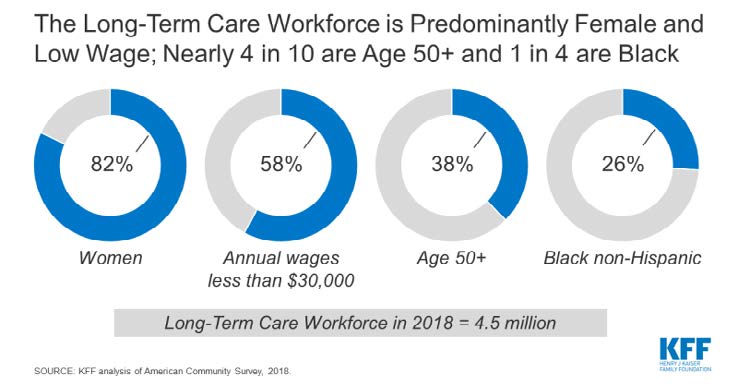Authors: Jane Feagin, Tess Simons

The COVID-19 pandemic is presenting significant challenges for many segments of the healthcare industry, including long-term care (LTC) settings such as skilled nursing facilities (SNFs) and assisted living facilities (ALFs), which deliver clinical and personal care services. Maintaining appropriate staffing in senior living facilities is essential to providing a safe work environment for healthcare personnel (HCP) and safe resident care.
As COVID-19-related staffing shortages occur due to HCP exposures, illness or need to care for family members at home, senior living facilities must have plans and processes in place to mitigate them, including communication with HCP about actions they are taking to address shortages, maintain patient and HCP safety, and provide resources to assist with anxiety and stress.
Healthcare staffing and the workforce
Staffing concerns have been around since the beginning of healthcare. But how do you "fix" them? Meeting the staffing needs of your facility is one of the biggest challenges you will face in your day-to-day duties. Being the staffing coordinator is a job that requires much hard work, patience and love for your facility.
Let's look at the makeup of the LTC workforce. The average LTC worker is primarily female, earns a lower wage and is typically age 50-plus. One in four is Black. So when you look at this picture of your average caregiver, you must consider the many challenges they face daily. These challenges include meeting their financial responsibilities, the time constraints of their jobs, and the emotional and physical strain of being a caregiver.

The senior living industry is all about healing and caring. Care team members must be trusted advisors, show compassion, and give reassurance and empathy. Leadership must display these qualities to set an example for their teams and nurture a positive outlook.
We've all heard horror stories about hiring the wrong people. Maybe that person wasn't qualified, lacked a solid work ethic or had a bad attitude. For all those reasons and more, LTC recruiters and HR managers must strive to hire the right person for each role. However, doing that without the right process and safeguards in place is nearly impossible, so we will provide some safeguards to help you with your hiring.
Performing a needs assessment
First, you will need to perform a needs assessment to identify gaps in your staffing plan by collecting information that will allow you to have a current inventory of your staff, their competencies and where they are lacking. Prioritizing your facility's staffing concerns will be the first step in addressing your care team and their needs.
Incorporating retention measures
What are you doing for employee retention? The days when pizza parties and cookies kept your staff motivated and loyal are gone. Employers must consider what they can do for their employees as much as they consider what their employees can do for them.
Adapt to the changing needs of your workforce. The needs of employees have changed and will continue to evolve. To remain competitive, we have to constantly reevaluate what we're offering them. What employees look for in a job has also changed, so don't be afraid to try new things, like:
- Schedules that meet their needs
- Regular feedback and recognition for their work
- Pay schedules that fit their budgets
Healthcare recruiting with texting
Are you using texting to recruit and hire? Many millennial and Generation Z candidates use text as a primary means of communication. Not only is it critical that the entire hiring process is mobile friendly and paperless, but adopting texting as part of the hiring process significantly enhances your ability to connect with and acquire qualified talent. Studies demonstrate that 90% of texts are read within three minutes, and the average response time is three minutes as well, as compared to 47 minutes with emails. Speed is critical in the recruitment world, and texting provides the means to supercharge the process.
The recruitment process can sometimes be delayed by candidates' needs, such as document requests, scheduling conflicts or offer letter details. Texting candidates can make the process more efficient.
Additionally, texting applicants modernizes your organization and gives you a leg up on those organizations that are still playing phone tag with candidates.
But make sure you provide candidates with the ability to opt out of the texting feature. As candidates move through your hiring process, they may want to unsubscribe from texts in order to avoid additional messaging or data charges.
Employing technology
Automation is also key in reducing time to hire and creating a more efficient recruitment process for your organization. Artificial intelligence-enabled conversations increase the speed at which your organization identifies, evaluates and hires a new candidate. It can also add a much-needed human touch to the hiring process, while also giving candidates the transparency they desire.
Conclusion – Remaining competitive in healthcare staffing
We are all competing for the same great people. To remain competitive, we have to reevaluate what we're offering employees. Have a plan for recruitment and retention, and start with the basics that we have outlined. This is an all-encompassing plan from start to finish, with the goal of hiring the right person who is the right fit for your facility and your residents.
In addition, you can use the following recruiting plan of action form to identify opportunities for your facility to improve the hiring process in order to lower costs, reduce turnover, and improve staffing and quality care issues.
Recruiting plan of action
Purpose: To identify opportunities for your facility to improve the hiring process in order to lower costs, reduce turnover, and improve staffing and quality care issues.


